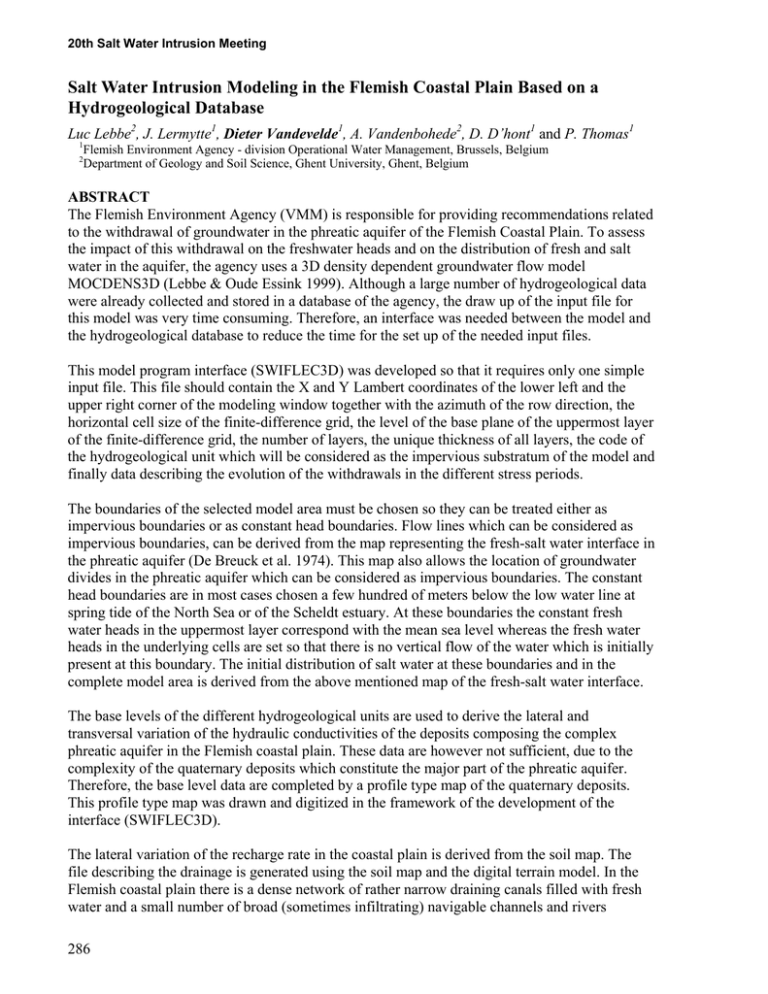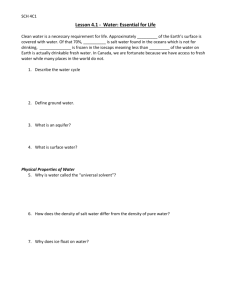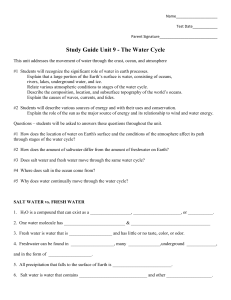Salt Water Intrusion Modeling in the Flemish Coastal Plain Based... Hydrogeological Database Luc Lebbe
advertisement

20th Salt Water Intrusion Meeting Salt Water Intrusion Modeling in the Flemish Coastal Plain Based on a Hydrogeological Database Luc Lebbe2, J. Lermytte1, Dieter Vandevelde1, A. Vandenbohede2, D. D’hont1 and P. Thomas1 1 Flemish Environment Agency - division Operational Water Management, Brussels, Belgium Department of Geology and Soil Science, Ghent University, Ghent, Belgium 2 ABSTRACT The Flemish Environment Agency (VMM) is responsible for providing recommendations related to the withdrawal of groundwater in the phreatic aquifer of the Flemish Coastal Plain. To assess the impact of this withdrawal on the freshwater heads and on the distribution of fresh and salt water in the aquifer, the agency uses a 3D density dependent groundwater flow model MOCDENS3D (Lebbe & Oude Essink 1999). Although a large number of hydrogeological data were already collected and stored in a database of the agency, the draw up of the input file for this model was very time consuming. Therefore, an interface was needed between the model and the hydrogeological database to reduce the time for the set up of the needed input files. This model program interface (SWIFLEC3D) was developed so that it requires only one simple input file. This file should contain the X and Y Lambert coordinates of the lower left and the upper right corner of the modeling window together with the azimuth of the row direction, the horizontal cell size of the finite-difference grid, the level of the base plane of the uppermost layer of the finite-difference grid, the number of layers, the unique thickness of all layers, the code of the hydrogeological unit which will be considered as the impervious substratum of the model and finally data describing the evolution of the withdrawals in the different stress periods. The boundaries of the selected model area must be chosen so they can be treated either as impervious boundaries or as constant head boundaries. Flow lines which can be considered as impervious boundaries, can be derived from the map representing the fresh-salt water interface in the phreatic aquifer (De Breuck et al. 1974). This map also allows the location of groundwater divides in the phreatic aquifer which can be considered as impervious boundaries. The constant head boundaries are in most cases chosen a few hundred of meters below the low water line at spring tide of the North Sea or of the Scheldt estuary. At these boundaries the constant fresh water heads in the uppermost layer correspond with the mean sea level whereas the fresh water heads in the underlying cells are set so that there is no vertical flow of the water which is initially present at this boundary. The initial distribution of salt water at these boundaries and in the complete model area is derived from the above mentioned map of the fresh-salt water interface. The base levels of the different hydrogeological units are used to derive the lateral and transversal variation of the hydraulic conductivities of the deposits composing the complex phreatic aquifer in the Flemish coastal plain. These data are however not sufficient, due to the complexity of the quaternary deposits which constitute the major part of the phreatic aquifer. Therefore, the base level data are completed by a profile type map of the quaternary deposits. This profile type map was drawn and digitized in the framework of the development of the interface (SWIFLEC3D). The lateral variation of the recharge rate in the coastal plain is derived from the soil map. The file describing the drainage is generated using the soil map and the digital terrain model. In the Flemish coastal plain there is a dense network of rather narrow draining canals filled with fresh water and a small number of broad (sometimes infiltrating) navigable channels and rivers 286 June 23-27, 2008 z Naples, Florida, USA containing salt water which are related or connected to the harbors of Nieuwpoort, Oostende or Zeebrugge. The file including the information of the interaction between the phreatic aquifer and these surface waters is made by means of two files already present in the database. The first file contains the location and the characteristic level, width, conductance of the riverbed of the narrow drainage canals. The second file contains the location and the characteristic of the navigable waterways and data of their water quality. The application of the model interface (SWIFLEC3D) will be demonstrated by means of a groundwater withdrawal problem of which the VMM had to assess the impact on the freshwater heads and on the distribution of the salt content in the groundwater. In the Flemish coastal plain large amounts of fresh water are withdrawn in a relatively short time at very large discharge rates during the construction of large apartment buildings. This is one of the typical problems regarding the management of the limited amount of fresh water in the coastal plain. The studied problem is situated near the IJzer Estuary. In the time span of two years three buildings have been constructed. During the construction of the underground car parks, large amounts of fresh water were withdrawn. The three construction places were located close to the entrance of the harbor of Nieuwpoort. The distance between estuary and the construction sites was about 200 meter. The first withdrawal started at construction site 1 at May 13, 2005. This withdrawal lasted one year at an average discharge rate of 960 m³/d. The second withdrawal started at October 28, 2005 and ended at December 31, 2005; it had an average discharge rate of 1430 m³/d and it was located at 600 m north of site 1. The third withdrawal started at December 5, 2005 and ended July 10, 2007; it had an average discharge rate of 900 m³/d and was located between the first two withdrawals at about 200 m north of site 1. During the studied period (788 d) 0.97x106 m³ water was pumped from the phreatic aquifer. The applied finite-difference grid consists of 12 layers, 54 columns, 83 rows and 6 different stress periods are considered. The horizontal cell size is 50 m. All layers have the same thickness of 1.5 m. The northern constant head boundary is situated 400 m north of the low water line at spring tide. The western and eastern boundaries are situated perpendicular to the coast line. Both are considered impervious because they coincide mainly with ground water flow lines. The northern half of the eastern boundary is located under the harbor of Nieuwpoort. The estuary and harbor are filled with salt water. The western half of the southern boundary is located in the artificially drained polder area with salt water in the lower part of the phreatic aquifer. The eastern half runs through an old dune ridge where the phreatic aquifer is mainly filled with fresh water (De Breuck et al, 1974). As described above the model interface (SWIFLEC3D) generates all input files for the MOCDENS3D model automatically, based on the information present in the hydrogeological database. The parameters determining the solute transport are held constant for all layers. The water conducting porosity is 0.38; the longitudinal dispersivity is 0.3 m; the horizontal transversal dispersivity is 0.05 m and the vertical transversal dispersivity is 0.03 m. A limited number of results are depicted in the Figure 1 and 2 and are drawn by the graphical interface Visual MOCDENS3D (Vandenbohede 2007). These figures are used to describe the treated problem and to assess the impact of the withdrawal on the freshwater heads and on the distribution of the salt water percentages. In Figure 1 the contour lines of fresh water heads (in white) and of saltwater percentages (shades) are plotted for the level -12 m bmsl (below mean sea level) before (left part) and after (right) the water withdrawals. On this level the major part of the phreatic aquifer is filled with salt water under the sea (northern boundary), under the harbor and river estuary (bottle shaped area) and in the polder area (the western half of the southern 287 20th Salt Water Intrusion Meeting boundary). The three withdrawal sites are located around the north western corner of the harbor. At the end of the withdrawal there is still a depression cone around the last and most important withdrawal. This withdrawal attracts the salt water from under the harbor to the depression cone. This salt water intrusion is also depicted in a west-east cross section through the last withdrawal site (Figure 2). From this figure it becomes clear that the salt water advances laterally to the pumping area in the lower part of the aquifer and that there is an upward flow of salt and brackish water just underneath the lowest level of the well screen where the transition zone between the fresh and the salt water becomes larger. Figure 1. Contour lines of fresh water heads (in white) and saltwater percentages (shades) in layer 8 of finite-difference model (12 m below mean sea level) just before the start (left) and at the end (right) of the groundwater withdrawal of which its evolution is given in the text (x- and y-axis in meter). 288 June 23-27, 2008 z Naples, Florida, USA Figure 2. Vertical cross-section parallel to the x-axis (at y = 2175m in Figure 1): just before the start (above) and at the end (below) of the water withdrawal (vertical axis level in m below mean sea level, horizontal distance to the western boundary in meter). Remark the depression cone around the withdrawal (screen is white bar) in the lower half of the figure. REFERENCES De Breuck, W., G. De Moor, R. Maréchal, and R. Tavernier. 1974. Depth of the fresh-salt water interface in the unconfined aquifer of the Belgian coastal area (1963-1973). Appendix of Proceedings of 4th Salt Water Intrusion Meeting, Ghent, University of Ghent. Lebbe, L. and G. Oude Essink. 1999. Section 12.11. MOC DENSITY / MOCDENS3D-code. p. 434-439, in Chapter 12. Survey of Computer codes and Case Histories, Eds. Sorek, S. & Pinder, G.F. in: Seawater Intrusion in Coastal Aquifers, Concepts, Methods and Practices. Eds. Bear, J., Cheng, H-D, Herrera, I., Sorek, S. and Ouazar D. Kluwer Academic Publishers Vandenbohede, A. 2007. Visual MOCDENS3D: visualizations and processing software for MOCDENS3D, a 3D density dependent groundwater flow and solute transport model. User Manual. Research Unit Groundwater Modeling, Ghent University. Contact Information: Dieter Vandevelde, VMM – div. Operational Water Management, Koning Albert II-laan 20, 1000 Brussels, Belgium, Phone: 32-50454257, Email: di.vandevelde@vmm.be 289







